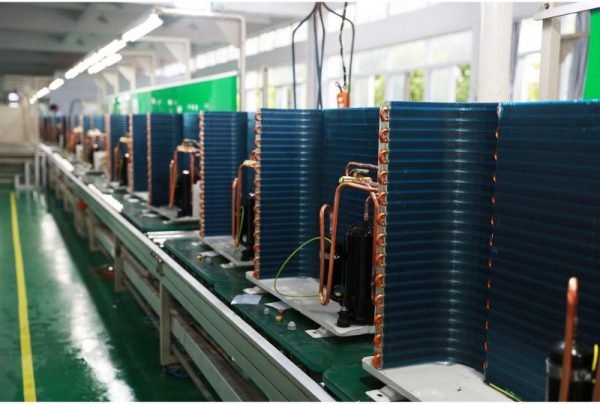Berikut adalah suhu yang biasa digunakan untuk unit penyejukan. Anda perlu memahaminya dan memberi perhatian kepada perbezaan mereka semasa penyelenggaraan harian.
Suhu pelepasan
Suhu pelepasan (juga dikenali sebagai suhu ekzos) unit penyejukan merujuk kepada suhu penyejuk kerana ia keluar dari pemampat. Ini adalah parameter kritikal dalam sistem penyejukan, kerana ia mencerminkan keadaan termal penyejuk selepas pemampatan. Suhu pelepasan biasanya berada dalam julat 50° C ~ 120 ° C. (122° F ~ 248 ° F.).
Suhu pelepasan tinggi dapat menunjukkan isu -isu yang berpotensi seperti:
1. Terlalu panas: Boleh merosakkan pemampat atau menyebabkan pelincir degradasi.
2. Tahap penyejuk yang tidak betul: Terlalu banyak atau terlalu sedikit penyejuk dapat menjejaskan kecekapan sistem.
3. Pertukaran haba yang lemah: Pelesapan haba yang tidak cekap di pemeluwap boleh meningkatkan suhu pelepasan.
4. Suction High Superheat: Superheat yang berlebihan di salur masuk pemampat boleh menyebabkan suhu pelepasan tinggi.
Suhu shell pemampat
Suhu shell pemampat merujuk kepada suhu permukaan luar selongsong pemampat semasa operasi. Ini adalah penunjuk haba yang dihasilkan dalam pemampat sebagai hasil kerja mekanikal dan mampatan penyejuk.
Faktor utama memberi kesan Pemampat Suhu shell
1. Beban pemampat: Beban yang lebih tinggi boleh menyebabkan peningkatan geseran dalaman dan haba.
2. Suhu ambien: Persekitaran sekitar dapat mempengaruhi kecekapan penyejukan pemampat.
3. Ciri penyejuk: Jenis dan keadaan penyejuk mempengaruhi ciri terma sistem.
4. Kecekapan sistem: Masalah seperti pelinciran yang lemah, Penapis tersumbat, atau penyejukan yang tidak mencukupi dapat meningkatkan suhu shell.
Julat biasa: Suhu shell berbeza mengikut reka bentuk dan sistem tetapi lebih rendah daripada suhu pelepasan. Bagi kebanyakan sistem, suhu shell boleh berkisar antara 40° C ~ 90 ° C. (104° F ~ 194 ° F.). Penting untuk tinggal di dalam pengeluar’ had yang disyorkan untuk mengelakkan terlalu panas dan kerosakan yang berpotensi kepada pemampat.
Suhu shell monitor biasa dapat membantu mengesan tanda -tanda awal ketidakcekapan atau kegagalan dalam sistem penyejukan.
Suhu pemeluwapan
Suhu pemeluwapan merujuk kepada suhu di mana bahan penyejuk Perubahan dari wap ke status cecair dalam pemeluwap semasa kitaran penyejukan. Ini berlaku di bawah tekanan tertentu, dikenali sebagai tekanan pemeluwapan, yang ditentukan oleh reka bentuk sistem dan keadaan operasi.
Pemeluwapan suhu pelbagai
Pemeluwap udara yang disejukkan
Keperluan suhu pemeluwapan 10° C ~ 15 ° C. (18° F ~ 27 ° F.) lebih tinggi daripada suhu ambien.
Sebagai contoh, Sekiranya suhu ambien adalah 30 ° C (86°F), suhu pemeluwapan akan berkisar dari 40° C ~ 45 ° C. (104° F ~ 113 ° F.).
Pemeluwap air yang disejukkan
Keperluan suhu pemeluwapan 3° C ~ 8 ° C. (5° F ~ 15 ° F.) lebih tinggi daripada suhu air masuk.
Sebagai contoh, Sekiranya suhu masuk air penyejuk adalah 25 ° C (77°F), suhu pemeluwapan akan berkisar dari 28° C ~ 33 ° C. (82° F ~ 91 ° F.).
Perkara utama mengenai suhu pemeluwapan
1. Hubungan dengan penolakan haba: Suhu pemeluwapan mencerminkan titik di mana penyejuk melepaskan haba ke persekitaran sekitar (udara atau air) dalam kondensor.
2. Kecekapan sistem: Suhu pemeluwapan yang optimum adalah penting untuk mengekalkan kecekapan sistem. Suhu pemeluwapan yang tinggi dapat menunjukkan pemindahan haba yang lemah atau prestasi pemeluwap yang tidak mencukupi.
Suhu shell kondensor
Suhu shell kondensor merujuk kepada suhu permukaan selongsong atau shell luar semasa operasi. Suhu ini menunjukkan betapa berkesannya pemeluwap menghilangkan haba yang diserap dari penyejuk ke persekitaran sekitar.
Biasanya sedikit di atas suhu udara ambien, lebih kurang. 2° C ~ 15 ° C. (4° F ~ 27 ° F.) lebih tinggi.
Mata utama mengenai suhu shell kondensor
1. Penunjuk penolakan haba: Suhu shell mencerminkan pemindahan haba yang berlaku dalam kondensor. Ia harus lebih rendah daripada suhu pemeluwapan penyejuk.
2. Mempengaruhi faktor:
Keadaan ambien–Suhu udara ambien atau air yang lebih tinggi dapat meningkatkan suhu shell dalam sistem penyejukan udara atau air yang disejukkan.
Kecekapan kondensor–Kotoran, Fouling, atau aliran udara yang lemah boleh menyebabkan pemindahan haba yang tidak cekap dan suhu shell yang tinggi.
Tekanan dan beban penyejuk–Beban sistem yang berlebihan atau tekanan penyejuk dapat meningkatkan haba dalaman, mempengaruhi suhu shell.
Suhu penerima
Suhu penerima merujuk kepada suhu penyejuk yang disimpan di penerima cecair sistem penyejukan. Penerima Cecair adalah kapal yang terletak selepas pemeluwap, boleh menyimpan dan mengawal bekalan penyejuk cecair ke injap pengembangan atau komponen hiliran lain.
Mata Utama Mengenai Suhu Penerima
1. Hubungan dengan suhu pemeluwapan
Suhu penerima hampir dengan suhu pemeluwapan kerana penyejuk di penerima berada dalam keadaan cecair tepu atau subcooled.
Ia mungkin sedikit lebih rendah daripada suhu pemeluwapan jika subcooling berlaku sebelum penyejuk memasuki penerima.
2. Petunjuk Operasi Sistem
Suhu penerima biasa menunjukkan operasi sistem yang betul, dengan penyingkiran haba yang mencukupi di kondensor.
Peningkatan suhu boleh mencadangkan masalah seperti penyejukan kondensor yang tidak mencukupi atau keadaan ambien yang tinggi.
3. Kadar suhu
Untuk sistem yang disejukkan udara, suhu penerima adalah 5° C ~ 10 ° C. (9° F ~ 18 ° F.) di bawah suhu pemeluwapan.
Untuk sistem yang disejukkan air, perbezaannya mungkin lebih kecil kerana kecekapan penyejukan yang lebih baik.
Suhu penapis
Suhu penapis merujuk kepada suhu penyejuk ketika ia melewati penapis atau penapis-pengering dalam sistem penyejukan. Penapis-pengering adalah komponen yang digunakan untuk mengeluarkan kelembapan, kotoran, dan bahan pencemar lain dari penyejuk untuk melindungi sistem dan memastikan operasi yang cekap.
Mata utama mengenai suhu penapis
1. Keadaan penyejuk
Penyejuk melalui penapis berada dalam keadaan cecair atau subcooled di bahagian tekanan tinggi sistem.
Dalam sesetengah sistem, Ia juga boleh mengendalikan penyejuk wap di bahagian tekanan rendah.
2. Julat suhu biasa
Suhu penapis harus dekat dengan suhu cecair subcooled penyejuk.
Ia 5° C ~ 10 ° C. (9° F ~ 18 ° F.) lebih rendah daripada suhu pemeluwapan.
3. Petunjuk suhu yang tidak normal
Penurunan suhu merentasi penapis mungkin menunjukkan penyumbatan separa yang disebabkan oleh kotoran, ais, atau serpihan.
Kenaikan suhu boleh mencadangkan masalah aliran penyejuk atau komponen yang terlalu panas disebabkan oleh ketidakcekapan sistem.
Suhu sedutan
Suhu sedutan (atau suhu masuk) merujuk kepada suhu penyejuk kerana ia memasuki pemampat melalui garis sedutan dalam sistem penyejukan. Suhu ini adalah parameter kritikal untuk prestasi sistem dan kesihatan pemampat.
Perkara utama mengenai suhu sedutan
1. Hubungan dengan keadaan penyejuk
Penyejuk berada dalam keadaan wap yang panas untuk memastikan tiada penyejuk cecair memasuki pemampat, yang boleh menyebabkan kerosakan.
2. Julat suhu biasa
Suhu sedutan sedikit lebih tinggi daripada suhu penyejat kerana penambahan superheat.
Nilai superheat biasa berkisar dari 5° C hingga 15 ° C. (9° F hingga 27 ° F.).
3. Kepentingan monitor
Suhu sedutan yang rendah: Menunjukkan superheat yang tidak mencukupi, Menangguhkan penyejuk cecair memasuki pemampat ( dikenali sebagai “slugging cecair”).
Suhu sedutan yang tinggi: Mencadangkan superheat yang berlebihan, yang dapat mengurangkan kecekapan sistem dan memanaskan pemampat.
Suhu TXV
Suhu yang dikaitkan dengan injap pengembangan termostatik (TXV) merujuk kepada suhu penyejuk atau kawasan sekitarnya yang mengawal injap dan deria. TXV mengawal aliran penyejuk ke penyejat berdasarkan panas panas penyejuk yang meninggalkan penyejat.
Suhu utama dalam operasi TXV
1. Suhu sensor
Sensor, dilampirkan ke garisan sedutan di saluran penyejat, mengukur suhu penyejuk.
Suhu ini menentukan superheat dan mengawal terbuka atau dekat TXV untuk mengawal aliran penyejuk.
Biasalah 5° C ~ 15 ° C. (9° F ~ 27 ° F.) di atas suhu tepu penyejat.
2. Suhu penyejuk di salur masuk TXV
Suhu penyejuk memasuki TXV adalah suhu cecair subcooled, yang sepatutnya sedikit lebih rendah daripada suhu pemeluwapan.
Secara amnya 5° C ~ 10 ° C. (9° F ~ 18 ° F.) di bawah suhu pemeluwapan.
3. Suhu penyejuk di outlet TXV
Setelah melalui TXV, suhu penyejuk jatuh dengan ketara disebabkan oleh pengembangan, mencapai suhu tepu penyejat.
Secara amnya 5° C ~ 10 ° C. (9° F ~ 18 ° F.) di bawah suhu pemeluwapan.
Suhu penyejatan
Suhu penyejatan (juga dikenali sebagai suhu menguap atau tepu) merujuk kepada suhu di mana penyejuk berubah dari cecair ke wap di dalam penyejat sistem penyejukan.
Perkara utama mengenai suhu penyejatan
1. Hubungan dengan keadaan penyejuk
Pada suhu yang menguap, Penyejuk menyerap haba dari persekitaran dan peralihan dari cecair ke wap.
2. Ditentukan oleh tekanan penyejat
Suhu penyejatan sepadan dengan suhu tepu pada tekanan yang diberikan di dalam penyejat. Hubungan ini bergantung pada jenis penyejuk yang digunakan.
Kadar suhu
Suhu penyejatan biasanya 5° C ~ 10 ° C. (9° F ~ 18 ° F.) di bawah suhu sasaran medium yang disejukkan (cth., udara atau air).
Untuk penghawa dingin sistem, julat adalah 2° C ~ 10 ° C. (36° F ~ 50 ° F.).
Untuk suhu rendah sistem penyejukan, ia boleh serendah -40° C ~ -10 ° C. (-40° F ~ 14 ° F.).
Suhu ambien luar
Suhu ambien luaran merujuk kepada suhu di luar sistem bangunan atau penyejukan. Ia adalah suhu luaran persekitaran di mana sistem beroperasi, Dan ia memainkan peranan penting dalam prestasi peralatan seperti kondenser yang disejukkan oleh udara atau unit luaran HVAC dan sistem penyejukan.
Perkara utama mengenai suhu ambien luaran
1. Kesan terhadap prestasi kondensor
Dalam sistem yang disejukkan udara, Suhu ambien luaran secara langsung mempengaruhi kecekapan pemeluwap. Suhu ambien yang lebih tinggi dapat mengurangkan keupayaan kondensor untuk menolak haba, membawa kepada tekanan dan suhu pelepasan yang lebih tinggi.
2. Beban sistem
Suhu luaran mempengaruhi beban penyejukan keseluruhan sistem. Sebagai contoh, dalam cuaca panas, Permintaan penyejukan lebih tinggi, yang boleh menjejaskan prestasi penyejukan dan sistem penyaman udara.
3. Variasi bermusim
Suhu ambien turun naik dengan musim, Hangat pada musim panas dan sejuk pada musim sejuk. Sistem mesti mengendalikan variasi ini dengan berkesan.
4. Julat suhu biasa
Julat suhu luaran boleh berbeza -beza bergantung kepada lokasi dan musim geografi, tetapi biasanya, ia boleh berkisar dari -10°C (14°F) pada musim sejuk hingga +40°C (104°F) atau lebih tinggi semasa musim panas di banyak kawasan.
5. Kepentingan dalam saiz dan operasi sistem
Jurutera mempertimbangkan suhu ambien luaran apabila reka bentuk sistem HVAC dan penyejukan untuk memastikan mereka dapat beroperasi dengan cekap di bawah keadaan suhu tinggi dan rendah.
Kesimpulan
Suhu ini dipengaruhi oleh faktor -faktor seperti keadaan ambien, Reka bentuk sistem, Jenis penyejuk,dan lain-lain.
Pemilihan dan penyelenggaraan yang betul, suhu adalah penting untuk mengoptimumkan kecekapan tenaga, Memastikan panjang umur sistem, dan memenuhi keperluan penyejukan atau pembekuan tertentu.
Sebarang komen?
Selamat tinggal tinggalkan mesej atau siarkan semula.














